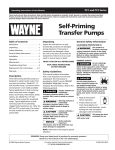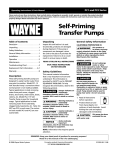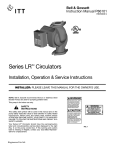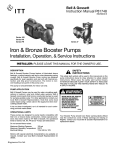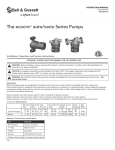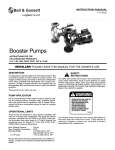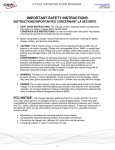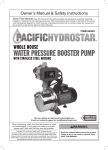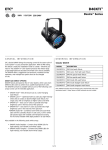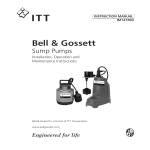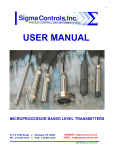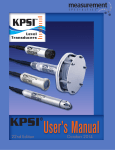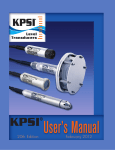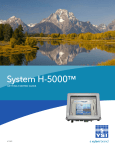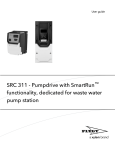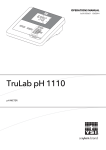Download P L™ Booster Pumps
Transcript
INSTRUCTION MANUAL P81884G UL C ® US ® LISTED P L™ Booster Pumps INSTALLER: PLEASE LEAVE THIS MANUAL FOR THE OWNER’S USE. SAFETY INSTRUCTIONS This safety alert symbol will be used in this manual and on the pump safety instructions decal to draw attention to safety related instructions. When used, the safety alert symbol means ATTENTION! BECOME ALERT! YOUR SAFETY IS INVOLVED! FAILURE TO FOLLOW THE INSTRUCTIONS MAY RESULT IN A SAFETY HAZARD. Your Series PL ™ Booster Pump should have the warning/ caution label and nonsubmersible warning label (Fig. 1) displayed on the pump conduit box. If this warning and caution is missing or illegible, contact your local Bell & Gossett Representative for a replacement. These pumps are designed to pump liquids compatible with their iron or bronze body construction. Maximum Working Pressure: 150 psi (10 bar) Maximum Operating Temperature: 225°F (107°C) Electrical Rating: 115V, 60 Hz, 1PH 230V, 60 Hz, 1PH Do not exceed these values. WARNING BEFORE INSTALLING, USING OR SERVICING THIS PRODUCT, READ THE INSTRUCTIONS. TO REDUCE RISK OF ELECTRICAL SHOCK SEE INSTRUCTIONS FOR PROPER INSTALLATION. CAUTION FOR SUPPLY CONNECTIONS USE WIRE SUITABLE FOR AT LEAST 90°C. USE COPPER CONDUCTORS ONLY. EMPLOYER DES FILS D’ALIMENTATION ADEQUATS POUR 90°C. FOR INDOOR USE ONLY. EMPLOYER UNIQUEMENT A L’INTERIEUR. DESCRIPTION The Series PL™ Booster Pump features permanently lubricated bearings, non-overloading permanent split capacitor motor with thermal protection and quiet operating construction. WARNING RISK OF ELECTRIC SHOCK; THIS PUMP HAS NOT BEEN INVESTIGATED FOR USE IN SWIMMING POOL AND MARINE AREAS. -NONSUBMERSIBLE PUMP- P86313 This pump is nonsubmersible, for indoor use only. OPERATIONAL LIMITS P48405 NOTE: Bell & Gossett recommends Bronze Booster Pumps be used for pumping potable water. FIG. 1 PUMP APPLICATION The Series PL™ Booster Pump may be used for water circulating applications in hydronic and solar systems. It has not been investigated, nor is it intended for use in swimming pool and marine areas. SAFETY REQUIREMENTS MECHANICAL SAFETY ELECTRICAL SAFETY WARNING: EXCESSIVE SYSTEM PRESSURE HAZARD The maximum working pressure of the pump is listed on the nameplate – DO NOT EXCEED THIS PRESSURE. Failure to follow these instructions could result in serious personal injury, death and/or property damage. WARNING: ELECTRICAL SHOCK HAZARD Electrical connections are to be made by a qualified electrician in accordance with all applicable codes, ordinances and good practices. Failure to follow these instructions could result in serious personal injury, death and/or property damage. WARNING: EXCESSIVE PRESSURE HAZARD – VOLUMETRIC EXPANSION The heating of water and other fluids causes volumetric expansion. The associated forces may cause failure of system components and the release of high temperature fluids. This can be prevented by installing properly sized and located expansion tanks and pressure relief valves. Failure to follow these instructions could result in serious personal injury, death and/or property damage. WARNING: ELECTRICAL GROUNDING HAZARD Adequate electrical grounding is required for the safe operation of B&G Pumps. The use of grounded metal conduit assures this requirement. If the means of connection to the supply-connection box (wiring compartment) is other than grounded metal conduit, ground the pump back to the service by connecting a copper conductor at least the size of the circuit conductors supplying the pump to the green grounding screw provided within the wiring compartment. Failure to follow these instructions could result in serious personal injury, death and/or property damage. THERMAL SAFETY WARNING: EXTREME TEMPERATURE HAZARD If the pump, motor, or piping are operating at extremely high or low temperature, guarding or insulation is required. Failure to follow these instructions could result in serious personal injury, death and/or property damage. 1. Close the valves on the suction and discharge sides of the pump. If no valves have been installed, it may be necessary to drain the system. WARNING: HOT WATER HAZARD Before draining the system, allow water to cool to 100°F max. open the drain valve (take precautions against water damage) and leave the drain valve open until servicing is complete. Failure to follow these instructions could result in serious personal injury, death and/or property damage. WARNING: ELECTRICAL SHOCK HAZARD Be certain the electrical power is not present at the motor leads before continuing. Failure to follow these instructions could result in serious personal injury or death. 2. Loosen the conduit box cover screw and remove the cover. WARNING: UNEXPECTED START-UP HAZARD Single phase motors are equipped with automatic reset overload protectors. The pump can restart without warning. Disconnect and lockout power before servicing. Failure to follow these instructions could result in serious personal injury, death and/or property damage. 3. Disconnect the electrical supply lines to the pump. WARNING: HIGH PRESSURE HAZARD Pressure may be present in the pump body. This pressure can be relieved by loosening the flange bolts and shifting the pump assembly slightly to allow the pressurized water to escape. Failure to follow these instructions could result in serious personal injury or death. 4. Remove the flange bolts and nuts and then remove the pump from the piping. PUMP INSTALLATION Locate the pump so there is sufficient room for inspection, maintenance and service. Bell & Gossett recommends the installation of service valves on the suction and discharge of all pumps to facilitate servicing or replacement of the pump without draining the system. Install suction and discharge flanges on the pipe ends. The use of teflon tape sealer or a high quality thread sealant is recommended. Be sure to minimize any pipe-strain on the pump. Support the suction and discharge piping by the use of pipe hangers near the pump. Line up the vertical and horizontal piping so that 2 Do not start pump until the system has been filled and vented. Air should be vented from the system by means of an air vent located at a high point in the system, or by an alternate method. The system must be completely vented prior to pump operation. Do not run pumps dry. Pump operation without water circulation could result in pump and motor damage. WARNING: HOT WATER HAZARD Make sure that each flange gasket remains seated in the flange groove during and after installation. Failure to follow these instructions could result in serious personal injury, death and/or property damage. WARNING: HOT WATER LEAKAGE HAZARD Pressurize the body slowly while checking for leaks at all joints with gaskets. Failure to follow these instructions could result in serious personal injury and/or property damage. Apply torque in even increments to both flange bolts until a value of 96-132 in-lbs. is reached. Both the suction and discharge flange bolts must be torqued in this manner. WARNING: WATER LEAKAGE HAZARD To prevent leakage, make certain that the flange bolts have been adequately torqued. Failure to follow these instructions could result in serious personal injury and/or property damage. MODE OF DISCHARGE The Series PL ™ pump can be installed to discharge up or down, horizontally, left or right, but the motor shaft must remain in the horizontal position, the arrow on the body must point in the direction of flow and the conduit box must be positioned on the top of the motor housing (see figure 2). WIRING INSTRUCTIONS WARNING: RISK OF ELECTRIC SHOCK Do not install this pump in swimming pool or marine areas. Failure to follow these instructions could result in serious personal injury, death and/or property damage. REMOVAL OF THE PUMP FROM EXISTING SYSTEM FOR REPLACEMENT WARNING: ELECTRICAL SHOCK HAZARD Disconnect and lockout the power before servicing. Failure to follow these instructions could result in serious personal injury or death. WARNING: HOT WATER HAZARD When disassembling a gasketed joint, always use a new gasket upon reassembly. NEVER RE-USE OLD GASKETS. Failure to follow these instructions could result in serious personal injury, death and/or property damage. WARNING: ELECTRICAL SHOCK HAZARD Disconnect and lockout the power before making electrical connections. Failure to follow these instructions could result in serious personal injury or death. A. Loosen the screw securing the conduit box cover (wiring compartment), and remove the screw & cover. B. Attach the appropriate size connector to the hole on the side of the conduit box. C. Using a minimum size 14 AWG copper electrical wire (refer to your local code for wiring restrictions), wire the motor to a single phase power source as listed on the pump nameplate. See Fig. 3. D. Connect the ground wire to the inside of the conduit box with one of the green screws provided inside the box. See Fig. 4. NOTE: Electrical supply and grounding wires must be suitable for at least 90°C (194°F). Bell & Gossett flange gaskets must be installed between the Series PL™ pump body flanges and the suction and discharge pipe flanges. Use 7/16" diameter x 11/2" long capscrew and matching nut to connect the pump to the flanges. PUMP BODY MAY BE ROTATED AS SHOWN, BUT CONDUIT BOX MUST REMAIN AT TOP. TYPICAL WIRING INSTALLATION SCHEMATIC FOR 1Ø POWER SOURCE NOTE: Series PL™ Booster Pumps are thermally protected and do not require external overload protection. WARNING: ELECTRICAL SHOCK HAZARD Be certain that all connections are secure and the conduit box cover is closed before electrical power is connected. Failure to follow these instructions could result in serious personal injury, death and/or property damage. SYSTEM PREPARATION the bolt-holes in the pump flanges match the bolt-holes in the pipe flanges. (DO NOT ATTEMPT TO SPRING THE SUCTION OR DISCHARGE LINES IN POSITION. THIS MAY RESULT IN UNWANTED STRESS IN THE PUMP BODY, FLANGE CONNECTIONS AND PIPING.) The code for Pressure Piping (ANSI B31.1) lists many types of supports available for various applications. FIG. 2 FUSIBLE DISCONNECT OR CIRCUIT BREAKER BY OTHERS TO REMOTE CONTROL IF REQUIRED PUMP MOTOR THERMALLY PROTECTED FIG. 3 Prior to pump start up, closed heating and cooling systems should be cleaned, drained and refilled with clean water. System ph must be maintained between 7 and 9. CONDUIT BOX WIRING DETAIL STARTUP CAUTION: SEAL DAMAGE HAZARD Do not run pump dry, seal damage may occur. Failure to follow these instructions could result in property damage and/or moderate personal injury. ALTERNATE GROUND SCREW FIG. 4 GREEN GROUND SCREW LINE LEADS 3 SAFETY REQUIREMENTS MECHANICAL SAFETY ELECTRICAL SAFETY WARNING: EXCESSIVE SYSTEM PRESSURE HAZARD The maximum working pressure of the pump is listed on the nameplate – DO NOT EXCEED THIS PRESSURE. Failure to follow these instructions could result in serious personal injury, death and/or property damage. WARNING: ELECTRICAL SHOCK HAZARD Electrical connections are to be made by a qualified electrician in accordance with all applicable codes, ordinances and good practices. Failure to follow these instructions could result in serious personal injury, death and/or property damage. WARNING: EXCESSIVE PRESSURE HAZARD – VOLUMETRIC EXPANSION The heating of water and other fluids causes volumetric expansion. The associated forces may cause failure of system components and the release of high temperature fluids. This can be prevented by installing properly sized and located expansion tanks and pressure relief valves. Failure to follow these instructions could result in serious personal injury, death and/or property damage. WARNING: ELECTRICAL GROUNDING HAZARD Adequate electrical grounding is required for the safe operation of B&G Pumps. The use of grounded metal conduit assures this requirement. If the means of connection to the supply-connection box (wiring compartment) is other than grounded metal conduit, ground the pump back to the service by connecting a copper conductor at least the size of the circuit conductors supplying the pump to the green grounding screw provided within the wiring compartment. Failure to follow these instructions could result in serious personal injury, death and/or property damage. THERMAL SAFETY WARNING: EXTREME TEMPERATURE HAZARD If the pump, motor, or piping are operating at extremely high or low temperature, guarding or insulation is required. Failure to follow these instructions could result in serious personal injury, death and/or property damage. 1. Close the valves on the suction and discharge sides of the pump. If no valves have been installed, it may be necessary to drain the system. WARNING: HOT WATER HAZARD Before draining the system, allow water to cool to 100°F max. open the drain valve (take precautions against water damage) and leave the drain valve open until servicing is complete. Failure to follow these instructions could result in serious personal injury, death and/or property damage. WARNING: ELECTRICAL SHOCK HAZARD Be certain the electrical power is not present at the motor leads before continuing. Failure to follow these instructions could result in serious personal injury or death. 2. Loosen the conduit box cover screw and remove the cover. WARNING: UNEXPECTED START-UP HAZARD Single phase motors are equipped with automatic reset overload protectors. The pump can restart without warning. Disconnect and lockout power before servicing. Failure to follow these instructions could result in serious personal injury, death and/or property damage. 3. Disconnect the electrical supply lines to the pump. WARNING: HIGH PRESSURE HAZARD Pressure may be present in the pump body. This pressure can be relieved by loosening the flange bolts and shifting the pump assembly slightly to allow the pressurized water to escape. Failure to follow these instructions could result in serious personal injury or death. 4. Remove the flange bolts and nuts and then remove the pump from the piping. PUMP INSTALLATION Locate the pump so there is sufficient room for inspection, maintenance and service. Bell & Gossett recommends the installation of service valves on the suction and discharge of all pumps to facilitate servicing or replacement of the pump without draining the system. Install suction and discharge flanges on the pipe ends. The use of teflon tape sealer or a high quality thread sealant is recommended. Be sure to minimize any pipe-strain on the pump. Support the suction and discharge piping by the use of pipe hangers near the pump. Line up the vertical and horizontal piping so that 2 Do not start pump until the system has been filled and vented. Air should be vented from the system by means of an air vent located at a high point in the system, or by an alternate method. The system must be completely vented prior to pump operation. Do not run pumps dry. Pump operation without water circulation could result in pump and motor damage. WARNING: HOT WATER HAZARD Make sure that each flange gasket remains seated in the flange groove during and after installation. Failure to follow these instructions could result in serious personal injury, death and/or property damage. WARNING: HOT WATER LEAKAGE HAZARD Pressurize the body slowly while checking for leaks at all joints with gaskets. Failure to follow these instructions could result in serious personal injury and/or property damage. Apply torque in even increments to both flange bolts until a value of 96-132 in-lbs. is reached. Both the suction and discharge flange bolts must be torqued in this manner. WARNING: WATER LEAKAGE HAZARD To prevent leakage, make certain that the flange bolts have been adequately torqued. Failure to follow these instructions could result in serious personal injury and/or property damage. MODE OF DISCHARGE The Series PL ™ pump can be installed to discharge up or down, horizontally, left or right, but the motor shaft must remain in the horizontal position, the arrow on the body must point in the direction of flow and the conduit box must be positioned on the top of the motor housing (see figure 2). WIRING INSTRUCTIONS WARNING: RISK OF ELECTRIC SHOCK Do not install this pump in swimming pool or marine areas. Failure to follow these instructions could result in serious personal injury, death and/or property damage. REMOVAL OF THE PUMP FROM EXISTING SYSTEM FOR REPLACEMENT WARNING: ELECTRICAL SHOCK HAZARD Disconnect and lockout the power before servicing. Failure to follow these instructions could result in serious personal injury or death. WARNING: HOT WATER HAZARD When disassembling a gasketed joint, always use a new gasket upon reassembly. NEVER RE-USE OLD GASKETS. Failure to follow these instructions could result in serious personal injury, death and/or property damage. WARNING: ELECTRICAL SHOCK HAZARD Disconnect and lockout the power before making electrical connections. Failure to follow these instructions could result in serious personal injury or death. A. Loosen the screw securing the conduit box cover (wiring compartment), and remove the screw & cover. B. Attach the appropriate size connector to the hole on the side of the conduit box. C. Using a minimum size 14 AWG copper electrical wire (refer to your local code for wiring restrictions), wire the motor to a single phase power source as listed on the pump nameplate. See Fig. 3. D. Connect the ground wire to the inside of the conduit box with one of the green screws provided inside the box. See Fig. 4. NOTE: Electrical supply and grounding wires must be suitable for at least 90°C (194°F). Bell & Gossett flange gaskets must be installed between the Series PL™ pump body flanges and the suction and discharge pipe flanges. Use 7/16" diameter x 11/2" long capscrew and matching nut to connect the pump to the flanges. PUMP BODY MAY BE ROTATED AS SHOWN, BUT CONDUIT BOX MUST REMAIN AT TOP. TYPICAL WIRING INSTALLATION SCHEMATIC FOR 1Ø POWER SOURCE NOTE: Series PL™ Booster Pumps are thermally protected and do not require external overload protection. WARNING: ELECTRICAL SHOCK HAZARD Be certain that all connections are secure and the conduit box cover is closed before electrical power is connected. Failure to follow these instructions could result in serious personal injury, death and/or property damage. SYSTEM PREPARATION the bolt-holes in the pump flanges match the bolt-holes in the pipe flanges. (DO NOT ATTEMPT TO SPRING THE SUCTION OR DISCHARGE LINES IN POSITION. THIS MAY RESULT IN UNWANTED STRESS IN THE PUMP BODY, FLANGE CONNECTIONS AND PIPING.) The code for Pressure Piping (ANSI B31.1) lists many types of supports available for various applications. FIG. 2 FUSIBLE DISCONNECT OR CIRCUIT BREAKER BY OTHERS TO REMOTE CONTROL IF REQUIRED PUMP MOTOR THERMALLY PROTECTED FIG. 3 Prior to pump start up, closed heating and cooling systems should be cleaned, drained and refilled with clean water. System ph must be maintained between 7 and 9. CONDUIT BOX WIRING DETAIL STARTUP CAUTION: SEAL DAMAGE HAZARD Do not run pump dry, seal damage may occur. Failure to follow these instructions could result in property damage and/or moderate personal injury. ALTERNATE GROUND SCREW FIG. 4 GREEN GROUND SCREW LINE LEADS 3 CONDUIT BOX SHAFT SLEEVE SEAL COMPONENTS PUMP BODY BODY GASKET COVER PLATE ASM REAR BEARING IMPELLER ASM W/THREADED HUB SEAL CUP SEAL SEAT SEAL SPRING O-RING BACKUP RING SEAL ASM FRONT BEARING SHAFT/ROTOR ASM CARBON SEAL HEAD SEAL CAGE Packaged together as an assembly HOUSING/STATOR ASM FIG. 5 INSTRUCTIONS FOR REPAIRING MECHANICAL SEAL 11. Follow steps 1 through 4 of section titled “REMOVAL OF PUMP FROM EXISTING SYSTEM FOR REPLACEMENT.” 12. Loosen the four capscrews that hold the motor housing to the pump body. Remove these screws and remove the housing from the pump body. 13. Place the pump on a flat work surface and insert a screwdriver into one of the endplate ventilation slots until it engages one of the rotor cooling fins. While holding the rotor with the screwdriver, turn the impeller clockwise. Note that the impeller is molded around a metal hub with a left hand thread. Remove the impeller from the shaft. 14. Remove the seal assembly from the shaft by sliding it off the shaft sleeve. 15. Clean the seal seat with a clean rag and inspect for grooving or cracks. If it shows no grooving or cracks, it may be cleaned and reused. Reposition the face plate on the motor housing. Gently tap the face plate evenly around its diameter to drive it into the recess provided in the motor housing. 18. Clean the shaft and sleeve before installing the new seal. 19. Slide the new carbon seal head onto the shaft sleeve until it contacts the seal seat. Slide the new “O-Ring” and back-up ring along the shaft sleeve until they fit inside the counter bore in the seal head. Place the seal spring between the back-up ring and the seal cage while positioning the seal cage flush with the end of the sleeve. Place the small end of the spring against the back-up ring. The three driving legs of the seal cage should engage the three slots on the seal head. While holding the rotor assembly with the screwdriver, thread the impeller onto the shaft in a counter clockwise direction. Tighten the impeller with light hand pressure. Take care to avoid bending a rotor cooling fin or damaging the shaft sleeve. 10. Clean the recess in the pump body and install a new body gasket. 16. If the seal seat is to be replaced, the face plate must be removed from the motor housing. Remove it by gently prying it away from the housing. 11. Install the pump in the body and secure with four capscrews. Apply torque evenly in a criss cross pattern in 40 in-lb (4.52 N•m) increments to a torque of 80 in-lb (9.04 N•m). 17. Remove the seal seat and cup. Lubricate the cup with soapy water and install new parts in the face plate recess. 12. Reinstall into the system using new flange gaskets. For instructions, see sections “PUMP INSTALLATION” and “WIRING INSTRUCTIONS” on pages 2 and 3. PERIODIC INSPECTION PERIODIC INSPECTION Bell & Gossett Booster Pumps are designed to provide years of trouble free service. It is recommended that periodic inspections be made to check for potential problems with the pump. If any leakage or evidence of leakage is present repair or replace the unit. Xylem Inc. 8200 N. Austin Avenue Morton Grove, Illinois 60053 Phone: (847) 966-3700 Fax: (847) 965-8379 www.xyleminc.com/brands/bellgossett Bell & Gossett is a trademark of Xylem Inc. or one of its subsidiaries. © 2012 Xylem Inc. P81884G April 2012




